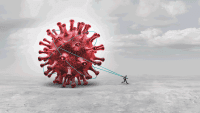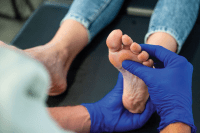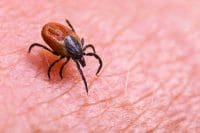There are many colloquialisms for syphilis, the sexually transmitted infection (STI) caused by Treponema pallidum. Whether it’s called “syfy,” “siff,” “pox,” “VD,” “the bug,” or “the sore,” syphilis infection is all too common in our communities, and the rate of infection has increased over the past decade, particularly in certain parts of the country. The syphilis epidemic warrants greater attention from all healthcare providers.
The great imitator
Syphilis is referred to as the “great imitator” because its initial symptoms are indistinguishable from those of many other illnesses. Syphilis can have very serious complications when left untreated, and poses a particular danger to neonates and infants. It’s transmitted through direct physical contact with a lesion (chancre) during oral, anal, or vaginal sex. Syphilis is easy to cure in the early stage, but if left untreated the complications are often emotionally devastating and physically scarring. Because the chancre can be hidden in the mouth, groin, vagina, or rectum, syphilis infection may go unnoticed by a sex partner.
Syphilis can be transmitted transplacentally or possibly at birth through contact with maternal lesions (congenital syphilis). The Centers for Disease Control and Prevention (CDC) recommends that all pregnant women be screened serologically at their first prenatal visit. Repeat testing is recommended at 28 weeks’ gestation and at delivery in communities with high syphilis morbidity, and for pregnant women who have not been tested or had a positive screening test in the first trimester. Additionally, any woman who delivers a stillborn infant after 20 weeks should be serologically tested for syphilis. In neonates and infants, syphilis can cause a multitude of symptoms including generalized skin rash, rhinitis, multiple organ failure, bone malformations, neurosensory hearing loss, and neuropsychological deficits, and can result in death.
Prevalence
Although rates of primary and secondary (P&S) syphilis in the United States in 2000 were the lowest (2.1 per 100,000 people) since reporting began in 1941, the rate has fluctuated since then, increasing from 2001 to 2009, decreasing in 2010, remaining unchanged in 2011, and then increasing again in 2013 to a reported 5.3 cases per 100,000 population—more than double the lowest-ever rate of 2.1 per 100,000 people reported in 2000.
It’s important to note that syphilis infection affects certain populations disproportionately:
- Overall, the biggest increases in syphilis infection occurred among men (9.3 cases per 100,000 individuals).
- Transmission of syphilis infection is highest (75% of reported 2012 P&S syphilis cases) among men who have sex with men (MSM). Among this population, high rates of HIV coinfection and high-risk sexual behaviors have also been reported.
- Infection rates are highest among non-Hispanic, Black men ages 20 to 29 and nonHispanic, Black women ages 20 to 24.
In 2012 the states with the highest rates of syphilis per capita, in order of prevalence, were Georgia, California, Louisiana, Maryland, Florida, Texas, New York, Illinois, Arkansas, and Oregon. Syphilis infection occurs throughout the country, but according to the CDC, half of the total number of P&S syphilis cases were reported in just 26 counties and 2 cities. (See Middle America: A city in review.)
Syphilis in America: The tale of a midwestern cityAccording to the CDC, Cincinnati, a midsized midwestern city in Hamilton County, Ohio, is ranked sixth in the country for P&S syphilis cases per capita. Hamilton County as a whole has the highest rate of syphilis in Ohio. In March 2012 the Hamilton County Health Commissioner declared a syphilis epidemic in Hamilton County, where the rate of syphilis in 2011 was reported to be 24.2 per 100,000 people. The Hamilton County declaration required that all hospital emergency departments in the County screen any person exhibiting STI symptoms, and that treatment be initiated if test results were positive. Positive laboratory tests were automatically sent to the Hamilton County Public Health Department per CDC regulations. Disease Investigation Specialists (DIS) contacted all individuals testing positive, ensured they were receiving treatment, obtained contact information, and offered confidential partner notification services. The DIS also provided risk-reduction counseling and education. The rate of congenital syphilis in this midsized midwestern city in 2012 was 54.6 per 100,000 people—seven times the national Healthy People 2020 goal of 9.1 per 100,000. To further put this in perspective, in 2012 the CDC reported that the national rate of congenital syphilis was 7.8 cases per 100,000 live births, the lowest rate of congenital syphilis recorded since 1988. By the end of 2012, educational programs for physicians, nurse practitioners, and nurse midwives, as well as community education for the public, were in place to help prevent future syphilis cases. The number of congenital syphilis cases for the first 8 months of 2013 stood at 5, which put the city on track for 7 to 8 cases for the year, more in line with the national trend. Although the rates of congenital infection have fallen, the epidemic remains very much a concern. |
Risk factors
Recent increases in the syphilis infection rate illustrate the need to ensure that any person with manifestations of syphilis infection be tested. Risk factors for individuals with syphilis infections include:
- high-risk sexual practices (having unprotected vaginal, anal, or oral sexual contact; coerced sex; multiple sexual partners; and a partner or partners who have tested positive for syphilis)
- using drugs and alcohol
- HIV positive
- no prenatal care
- poor socioeconomic status
- African American
- male age 20 to 29; female age 20 to 24.
Based on these risks, providers should routinely test persons fitting any of these categories, in addition to pregnant women or members of at-risk subpopulations (for example, persons in correctional facilities and MSM).
Testing for syphilis
The CDC recommends syphilis serologic screening with nontreponemal (nonspecific) tests (rapid plasma reagin [RPR] or venereal disease research laboratory [VDRL]) for anyone at risk or presenting with signs or symptoms of syphilis, or for anyone concerned about harboring any STIs. This testing identifies people with possible untreated or inadequately treated syphilis infection. Screening is followed by confirmation using a treponemal-specific test (fluorescent treponemal antibody absorption [FTA-ABS], microhemagglutination assay for Treponema pallidum [MHA-TP], Treponema pallidum enzyme immunoassay [TP-EIA], Treponema pallidum particle agglutination [TP-PA]).
Some laboratories begin screening using treponemal rather than nontreponemal tests because of manpower and cost issues. However, this “reverse sequence screening” approach is associated with high rates of false-positive results, and in 2011 the CDC reaffirmed its recommendation that the nontreponemal test be used to screen and the treponemal test be used for confirmation. The CDC recommends that all individuals who have syphilis be tested for HIV infection.
Syphilis progression
Although syphilis infection begins with what appears to be an innocuous sore, it can develop into something deadly if it is not treated.
Primary syphilis
In primary syphilis one or more painless chancres on the skin or mucous membrane appear at the inoculation site. Lesions commonly appear on the genitalia, but depending on the sexual contact during transmission, may appear elsewhere. The lesions appear approximately 3 weeks after initial exposure and heal spontaneously in a few weeks. Because the chancres are painless, they may go unrecognized.
Secondary syphilis
If primary syphilis is untreated, 1 to 2 months later a generalized reddish-brown spotted rash appears, typically on the soles and palms. Mucous membrane lesions, hypertrophic genital lesions (condylomata), often confused with genital warts, and chronically swollen lymph nodes occur. Other symptoms may include headache, fever, malaise, sore throat, enlargement of the spleen, weight loss, and joint pain. This acute stage typically spontaneously resolves in 3 to 12 weeks.
The characteristic classifications of secondary syphilis are as follows:
- Latent syphilis: Positive blood test, but no clinical manifestations.
- Early latent: Acquired within the preceding year.
- Late latent: Greater than 1 year’s duration or of unknown duration.
Tertiary syphilis
Tertiary syphilis occurs 5 to 20 years after latent syphilis, causing rubbery, tumorlike lesions known as gummas, as well as cardiovascular involvement and neurosyphilis (infection of the central nervous system). Manifestations of neurosyphilis may occur at any stage of infection, particularly in people infected with HIV and in neonates with congenital syphilis. Treatment at this stage cures the infection and stops future damage, but it cannot repair or reverse damage that has already occurred.
Congenital syphilis
When T. pallidum crosses the placenta, vertical transmission occurs. This can happen at any time in pregnancy and during any stage of the infection. Fetal infection causes intrauterine growth restriction, preterm birth, stillbirth, hydrops fetalis, low birthweight, neonatal death, congenital anomalies, and long-term sequelae. Approximately 80% of offspring of untreated mothers are affected by congenital syphilis. Congenital syphilis is a key indicator of community health, as it is an easily preventable illness when proper health care is provided.
Medication is the only treatment that eliminates syphilis
Treatment of syphilis is based on stage of infection. The CDC recommends long-acting benzathine penicillin G (2.4 million units administered intramuscularly) in a single dose as the preferred treatment for P&S syphilis for nonpregnant patients. For nonpregnant patients with late latent syphilis or latent syphilis of unknown duration three doses of long-acting benzathine penicillin G (2.4 million units administered intramuscularly) at weekly intervals.
Although data to support the use of alternatives to penicillin is limited, options for nonpregnant patients who are allergic to penicillin may include doxycycline, tetracycline, and potentially ceftriaxone. The CDC recommends that these therapies be used only in conjunction with close clinical and laboratory follow-up to ensure appropriate serologic response and cure.
For pregnant women only penicillin therapy can be used to treat syphilis and prevent vertical transmission of syphilis. Treatment with penicillin is extremely effective (success rate of 98%) in preventing mother-to-child transmission. A pregnant woman with a history of penicillin allergy should be treated with penicillin after desensitization. Desensitization should be performed after consultation with a specialist and in a facility where emergency assistance is available. Medications other than penicillin cannot be considered reliable to cure infection in the fetus.
Managing treatment for the sexual partner of the patient is an important step in eliminating syphilis infection from our communities. Transmission of T. pallidum is thought to occur only when syphilitic lesions are present. Although such manifestations are uncommon after the first year of infection, persons intimately exposed to a person who has syphilis in any stage should be evaluated clinically and serologically, as confirmation is necessary. If infected, they should be treated according to CDC recommendations, as previously described.
Implications for nursing care
Nurses are essential in the process of eradicating syphilis and are at the forefront of efforts to eradicate syphilis and advocate for a healthy lifestyle. People who are educated about all aspects of their health are empowered to change and improve their health and that of their offspring. Nurses educate and advocate for the public and our future generations. Better coordination among healthcare providers and the community in the reporting and follow-up of syphilis is equally important, and nurses can play a vital role in this endeavor.
Primary prevention involves educating our community on the importance of safe sex. Community education may involve neighborhood councils, religious institutions, recreation centers, student health centers, dormitories, and work settings. Education can occur anywhere and in many forms (for example, pamphlets can be posted prominently throughout the community).
Specifically, individuals need to know that the surest way to avoid transmission of syphilis is to abstain from sexual contact or to be in a long-term mutually monogamous relationship with a partner who has been tested and is uninfected. All members of the community must understand that correct and consistent use of condoms can reduce the risk of infection only when the infected area or site of potential exposure is protected, and that oral sex does not equal “safe sex.” After diagnosis, all sexual partners must be identified, notified, and treated as well, because syphilis is extremely contagious in the primary and secondary stages. Thus it is crucial that nurses are comfortable taking sexual histories, exploring sexual practices, teaching safe sex practices, making condoms available, and addressing patients’ risks and concerns.
Nurses are key in efforts of secondary prevention, ensuring that proper screening takes place. In addition, tertiary prevention is critical, in that the nurse interprets and confirms screening results, provides subsequent treatment if results are positive, and effectively communicates with the client. Finally, nurses should confirm that the syphilis infection has been reported to the county health department by the provider within the specified period of time.
Protecting our communities
Increasing community awareness about syphilis, a highly contagious infection with devastating sequelae, must become a priority in the community. Nurses are key to this process, which can be achieved through effective community outreach, including the use of free-standing clinics (vans), and billboards with patient-education content. (“Syphilis is here” was an effective billboard slogan used.) Only a multipronged approach that emphasizes the role of nurses in prevention and treatment of syphilis will allow for eradication of this devastating infection.
Selected references
American Academy of Pediatrics (AAP) Committee on Infectious Diseases. Red
Book: 2012 Report of the Committee on Infectious Diseases. 29th ed. Oak Grove Village, IL.
Carlson D. Hamilton County public health: Epidemiology and assessment. Syphilis Quarterly Report. 2013;2(2).
Centers for Disease Control and Prevention. Sexually transmitted diseases (STDs). Syphilis-CDC fact sheet (detailed). September 2015. www.cdc.gov/std/syphilis/STDFact-Syphilis-detailed.htm.
Centers for Disease Control and Prevention. 2013 sexually transmitted diseases surveillance. Syphilis profiles, 2013. www.cdc.gov/std/syphilis2013/default.htm
Davidson M, London M, Ladewig P. Olds’ Maternal-Newborn Nursing & Women’s Health Across the Lifespan. 9th ed. Upper Saddle River, NJ: Pearson Education; 2012.
Ingram T. Hamilton County syphilis epidemic. Presented at: 12th Annual Regional Perinatal Leaders’ Summit; October 18, 2013; Cincinnati, OH.
Patton ME, Su JR, Nelson R, Weinstock H. Primary and secondary syphilis—United States, 2005-2013. MMWR. 2014;63(18);402-406. www.cdc.gov/mmwr/preview/mmwrhtml/mm6318a4.htm
Mel Rosen is assistant professor of clinical instruction at the University of Cincinnati College of Nursing in Cincinnati, Ohio.


















